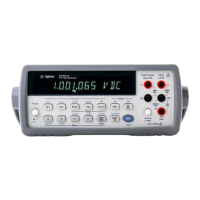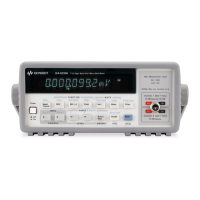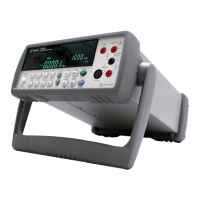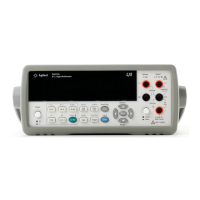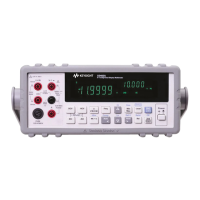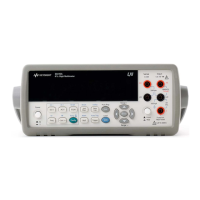114 Chapter 4 Making Measurements
Input Complete The input complete event (ICOMP event) is similar to the RCOMP event in
that it produces a 1µs pulse for each reading. However, when the ICOMP
event is specified, the pulse occurs when the A/D converter has finished
integrating the input signal but before the reading is complete (see Figure
20). The ICOMP event can be used with an external scanner when making a
single reading per scanner channel. This event is especially important when
using a slower (relay type) scanner. Since the ICOMP event occurs before
the reading is complete, it advances the scanner sooner than would the
RCOMP event. The following program uses the ICOMP event to make one
reading on each of 6 scanner channels. Notice that line 40 enables trigger
buffering. This prevents the multimeter from generating the TRIGGER TOO
FAST error should the scanner output a channel closed pulse before the
present reading is complete. Connections for this example are shown in
Figure 21.
10 OUTPUT 722;"PRESET NORM" !DCV, NRDGS,1,AUTO, TARM AUTO, TRIG SYN
20 OUTPUT 722;"MEM FIFO" !ENABLE READING MEMORY, FIFO MODE
30 OUTPUT 722;"TRIG EXT" !TRIGGER EVENT = EXTERNAL
40 OUTPUT 722;"TBUFF ON" !ENABLE TRIGGER BUFFERING
50 OUTPUT 722 "EXTOUT ICOMP,NEG" !INPUT COMPLETE EXTOUT, LOW-GOING TTL
55 !CONFIGURE EXTERNAL SCANNER
60 OUTPUT 709;"SADV EXTIN" !ADVANCE SCANNER ON MULTIMETER'S EXTOUT SIGNAL
70 OUTPUT 709;"CHCLOSED EXT" !OUTPUT LOW-GOING PULSE AFTER EACH CLOSURE
80 OUTPUT 709;"SCAN 201- 206" !SCAN CHANNELS 01 - 06 ON SCANNER IN SLOT 200
85 !AND ADVANCE TO CHANNEL 01 STARTING THE SCAN
90 END
Aperture Waveform When specified, the aperture waveform event (APER event) outputs a
waveform indicating when the A/D converter is measuring the input signal.
In addition to showing when a reading is being measured, the aperture
waveform also shows any autozero and autorange measurements being
made. This waveform can be used to synchronize external switching
equipment to the multimeter. For example, to ensure an electrically quiet
environment for high-accuracy measurements, it may be necessary to
suspend the operation of external switching equipment while the A/D
converter is integrating each reading. This can be done by enabling the APER
event and by programming the external switching to occur only when the
aperture waveform indicates that the A/D converter is not integrating the
input signal. To following program line enables the APER event with positive
polarity (see Figure 20):
OUTPUT 722;"EXTOUT APER,POS"
Service Request When specified, the service request event (SRQ event) produces a 1 µs pulse
whenever the multimeter generates a GPIB service request. This event can
be used to indicate to external equipment (especially equipment that cannot
be connected to GPIB) that one or more specified events have occurred and
have generated a service request (refer to "Using the Status Register" in
Chapter 3, for information on service requests).
Note When a status event sets the SRQ bit in the register, that bit remains set
until cleared (CSB command, for example). When specified, the EXTOUT
SRQ pulse occurs whenever any status event occurs that has been enabled

